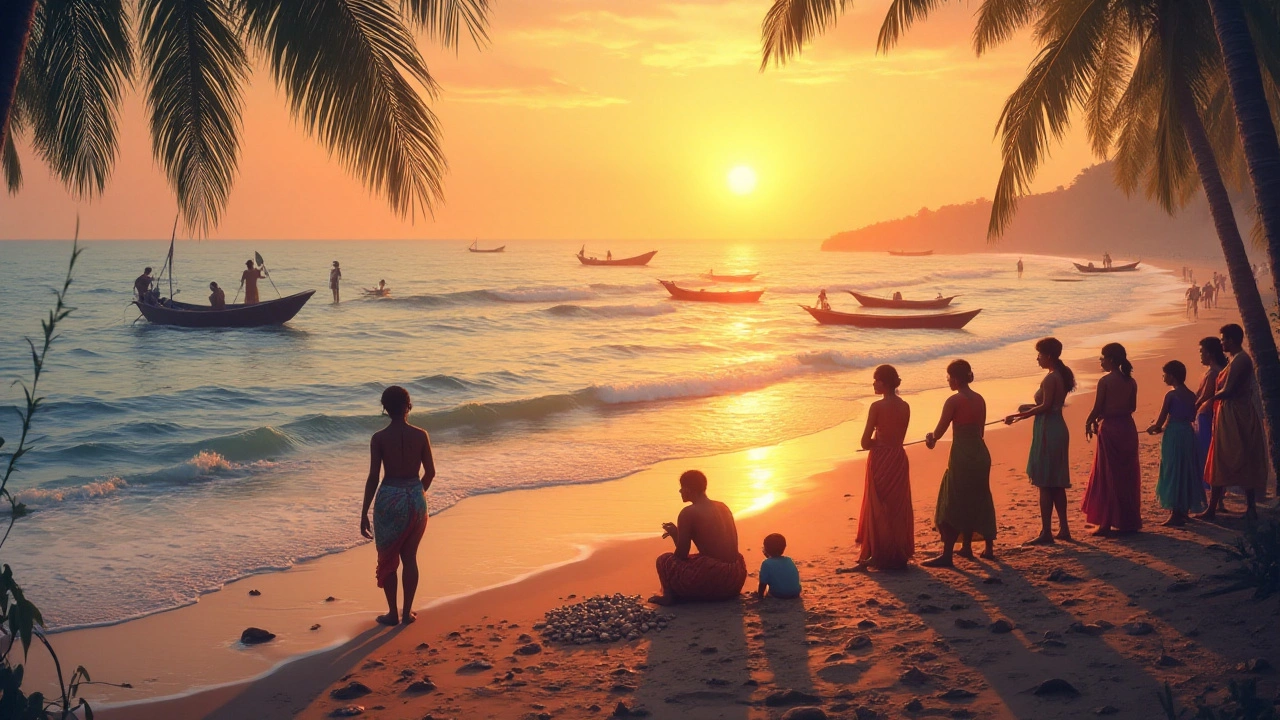India's stunning coastline stretches over 7,500 kilometers, offering an inviting mix of sandy beaches, vibrant marine life, and a unique cultural backdrop. However, while the azure waters may seem tempting, swimming in the sea requires caution and awareness.
For travelers, it's vital to grasp the local seaside conditions before diving in. The Indian Ocean's currents and tides can be surprisingly strong, and awareness of these elements is key to ensuring a safe dip. Furthermore, understanding the diverse marine ecosystem is essential, as some creatures can pose a danger to unsuspecting swimmers.
Another layer of consideration is environmental, with varying levels of pollution impacting the healthfulness of swimming areas. While some beaches maintain pristine conditions, others may deal with issues stemming from industrial and urban development.
This article provides insights and practical advice for those wishing to enjoy the Indian seas while prioritizing safety and sustainability. Equip yourself with the right knowledge and tips to make the most of your beachside adventure in India.
- Understanding Coastal Conditions
- Marine Life Awareness
- Pollution and Its Impact
- Safety Tips for Beachgoers
Understanding Coastal Conditions
When embracing the adventure of ocean swimming in India, it's imperative to understand the coastal makeup and the various elements influencing it. These factors are as dynamic and varied as the country’s culture and landscapes, whose charms are universally known. The currents of the Indian Ocean, Arabian Sea, and Bay of Bengal display particular characteristics that may surprise the uninitiated. Notably, the strong monsoon winds and tides play a pivotal role in molding these waters into forces of nature.
Areas like the famous beaches of Goa are idyllic for tourists, offering calmer waters ideal for swimming most of the year. However, during the monsoon season, from June to September, these serene waters can transform, whipped into turbulent waves by the seasonal gales. In such times, even the most experienced swimmers need to exercise caution. Interestingly, the ebb and flow of tides can vary dramatically, a feature beautifully discussed in
"The rhythm of India's sea tides tells a story of its own, elusive yet rhythmic, guiding the ebbs with a predictable unpredictability," remarked Dr. Rohit Kapoor, a renowned oceanographer.
Understanding the coastal topography can also guide decisions about swimming. Certain beach locales, like the picturesque coastal stretches of Kerala, are erosion-prone, leading to sudden drop-offs and submerged reefs. These underwater landscapes dance in the invisible layers of the sea, promising both beauty and hidden hazards. In regions like Tamil Nadu's Marina Beach, one of the world's longest urban beaches, the sea floor gradually deepens, yet the strong undercurrents demand an informed approach before plunging into the azure.
Beyond natural elements, seasonal fishing activities and vessels maneuvering along the coastal water can present navigational challenges for swimmers. The state's fishermen’s community, busy and bustling, present a vital aspect of the beaches ecosystem-in-action, requiring mutual respect and cautious interaction. A useful tip is acquainting oneself with local seasonal patterns; these can vary substantially between the western and eastern coasts, influenced by different ocean currents and regional weather variations.
A closer examination of the region reveals that beach safety is intimately tied to understanding these coastal conditions. Those eager to swim when the sea demonstrates its friendlier side will find optimal timing is often in the cooler months post-monsoon, from November to March. Keeping an eye on local weather forecasts and tidal patterns will undoubtedly enhance safety. Information boards at popular locations often provide essential updates, and consulting them before setting out into the ocean can greatly diminish risks.
Conclusively, while the allure of swimming in India's oceanic waters is undeniable, the importance of informed understanding cannot be overstated. With knowledge of regional patterns and respectful consideration of coastal dynamics, a swim in these pristine waters becomes an experience savored for its sheer joy and respect for nature. Prioritize a vigilant approach, and let India’s vibrant coastline etch unforgettable memories on your soul.
Marine Life Awareness
Swimming in the sea is a delightful experience, especially along the Indian coastline where the waters are home to a rich tapestry of marine life. From the colorful corals of the Andaman Islands to the tranquil backwaters of Kerala, these environments offer a unique opportunity to witness nature's underwater wonders. Yet, being informed about the marine life you might encounter is crucial to ensuring both your safety and the preservation of these habitats.
India's waters are replete with a diverse array of sea creatures. Jellyfish, for instance, can lurk just beneath the waves, hidden by their translucent bodies. While many varieties are harmless, some can deliver stings that cause discomfort or even be hazardous to those with allergies. It's wise to ask locals or lifeguards about recent jellyfish sightings before taking a dip. Marine Life Awareness also extends to understanding local fish species. Areas like the Lakshadweep islands boast a vibrant coral ecosystem with fish ranging from the friendly clownfish to the elusive barracuda. Engaging with local guides or dive instructors can offer valuable insight into which species are safe to observe from a distance.
Spotting Sea Turtles
An enchanting encounter with sea turtles can be the highlight of any seaside visit. The beaches of Goa and Odisha are known nesting grounds for these gentle reptiles. During the nesting season, conservation efforts may restrict certain areas to protect turtle hatchlings. Joining guided turtle walks or conservation tours is a rewarding way to learn more about these creatures while ensuring their safety.
According to a study by the Wildlife Institute of India, "awareness and visitor education play a pivotal role in the preservation of marine biodiversity".
Rays and Sharks: Majestic, Yet Concern-Worthy
While less common than turtles or fish, rays and sharks do inhabit Indian waters. The mention of sharks can spark a sense of adventure, yet it's essential to remember their presence emphasizes the need for swimming safety and respect for marine ecosystems. Encounters with these creatures are rare, but swimmers and snorkelers should avoid areas known for feeding or thick marine vegetation. Fortunately, the more populated beaches have protective measures like nets to limit interactions with larger marine animals.
To maximize ocean swimming safety, adhering to local guidelines and knowledge truly pays off. Beachgoers should rigidly follow any posted signs advising on marine life, and if unsure, opting to swim where lifeguards are present is always a good idea. Practicing the "look but don’t touch" rule is a simple yet effective way to enjoy the wonders of the Indian seascapes responsibly, allowing future visitors the same chance to share in these incredible experiences.

Pollution and Its Impact
The sprawling expanse of India's coastline, treasured for its scenic beaches and vibrant aquatic life, is facing increasingly concerning pollution challenges. These challenges stem from both human activities and natural occurrences. Industrial runoff, agricultural waste, and urban sewage frequently find their way into the seas, altering the delicate balance of marine ecosystems. While this pollution often goes unchecked, the local communities dependent on these waters for livelihood bear the brunt of the consequences. Tourist influxes, drawn by the allure of sandy shores and rich cultural tapestries, add to the waste problem. Yet, with awareness and action, swimmers can still find ways to appreciate these waters while advocating for their conservation.
Navigating the realities of pollution is essential for visitors hoping to enjoy India’s beaches safely. In places like Mumbai, where urbanization is rampant, reports have frequently highlighted contamination levels that exceed safe swimming margins. This calls for not just awareness but genuine caution when choosing which waters to enter. Goa, despite its reputation as a tropical paradise, contends with its share of issues, primarily due to seasonal overcrowding and insufficient waste management systems. However, initiatives are underway, with local and international organizations collaborating to reduce pollution levels and promote sustainable tourism.
Swimming safety in India often hinges on understanding these pollution factors and knowing which beaches maintain healthier conditions. As Indian beaches become increasingly popular, so does the need for environmentally responsible practices among both visitors and locals. Mindful choices—like avoiding single-use plastics and supporting eco-friendly businesses—can make a visible difference. Despite the challenges, stories of successful clean-up campaigns and community-led conservation efforts reflect a growing consciousness towards preserving these valuable coastal assets. Quotes from prominent figures shed light on the ongoing battle against pollution:
"The health of our oceans is a responsibility that rests with us all," remarked an environmental advocate during a recent summit.As such, awaiting a day at the beach in India promises not just sun and sea, but also a chance to contribute to sustainable ocean stewardship.
Safety Tips for Beachgoers
India's beaches hold a unique allure, drawing visitors from around the world who are eager to swim, sunbathe, and soak up the coastal ambiance. Yet, the tantalizing waters and white sands are not without their challenges. To make the most of your time by the sea, it’s important to pay close attention to a few vital safety precautions. Recognizing the power of the ocean is key; currents can sometimes be deceptive, offering a calm surface while hiding a strong undertow. Checking local weather and tide forecasts before heading to the beach can help avoid hazardous swimming conditions. On top of that, never underestimate the sun’s intensity, particularly between 10 a.m. and 4 p.m., when UV rays are most harmful. It's not just your skin that needs protection, but your eyes, too, with polarizing sunglasses being a smart addition to your beachwear.
Another aspect of beach safety involves being aware of local marine life. Some coastal areas in India are habitats for jellyfish, certain types of which can cause painful stings. Paying attention to flags and signs posted by lifeguards can offer guidance on where it's safe to swim. In Goa, for instance, beaches have a flag system indicating current swimming conditions; a red flag signals danger and advises swimmers to stay out of the water, while green denotes safer conditions. And it's not just jellyfish you need to be cautious about; stonefish and sea urchins also inhabit some Indian waters, so watch where you step while enjoying the ocean.
Ensuring you pick a beach with lifeguard presence adds an extra layer of security. Beaches like Juhu in Mumbai or Baga in Goa often have lifeguards on duty during peak season, ready to help when needed. While many larger beaches have well-marked areas monitored by professionals, the more secluded or untouched spots may not offer such safety nets. Swimming in designated areas helps keep you within reach of assistance if necessary. In addition, avoid swimming under the influence of alcohol, as it can impair your judgment and coordination, increasing the risk of accidents.
Being environmentally conscious also contributes to beach safety. Respecting the environment by disposing of waste properly and not disturbing wildlife ensures a cleaner and safer beach for everyone. Many Indian beaches, such as Marina Beach in Chennai and Mandarmani in West Bengal, have taken pollution seriously and enforce strict cleanliness protocols. Participating in or promoting clean-up activities supports local efforts to maintain these beautiful coastal areas. Interestingly, according to a UNEP report, public participation initiatives have shown to reduce coastal waste by up to 70% in some areas. Efforts like these make the environment better for both swimmers and marine life, inviting those to return time and again for a safe and enjoyable experience.
"A safe beach experience is often the product of mindful practices, informed choices, and respecting nature." – An Ocean Conservation Expert
In summary, enjoying India's diverse beaches means respecting the power of the ocean, understanding the local environment, and embracing safe practices. Being prepared not only ensures your personal safety but enhances the quality of these cherished destinations. Indulging safely will undoubtedly allow you to soak up the best of what India's coastline has to provide, making memories that will surely last a lifetime.
